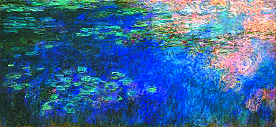Three “Water Lily” panels, displaying galaxies of brushstrokes, catch some new light
The redesigned Museum of Modern Art is nothing if not dramatic. The soaring ceilings, six-story drops from glass-partitioned passages and gymnasium-sized atrium all add up to an invigorating new space in which to view the world’s most important collection of modern art.
No piece is more successfully reinstalled than Claude Monet’s “Clouds Reflecting on the Water Lily Pond,” familiarly known as “Water Lilies.”
This outstanding horizontal triptych, the reflection of a life’s work, was completed in six years by 1926, near the end of the master’s life. The three panels, each measuring approximately 6 1/2 feet high by 14 feet long, are panoramically hung in the new Donald and Catherine Marron Atrium, the white-walled cavern that forms the museum’s core.
The vast surface of the painting is an amazing amalgamation of brush strokes, from layered applications, or impasto, that approximate sculpture, to the looser surface scumbling, or broad flickering, that reflects color and light. In scale and technique, this work conveys as thoroughly modern an approach as it did in the waning years of Impressionism, as fresh and alive, 85 years after its completion, as any of its “modern” counterparts today.
The color treatment speaks to its masterful handling—cerulean blues, bright yellows and an assortment of earth tones indicate Monet’s unorthodox execution of a painting on such a grand scale within the confines of a specially constructed studio.

The museum showcases this masterpiece, deservedly so. Hung low on an enormous white wall, the painting exists as did its natural subject, below the horizon. The sheer beauty and mastery of the work dominates the very handsome Brice Marden canvas and a mediocre Jasper Johns’ piece hung nearby. Despite Barnett Newman’s Cor-Ten steel sculpture, “Broken Obelisk,” that soars within the atrium, Monet’s panels are nonetheless poignant.
Having recently spent many hours in the new MoMA, I was repeatedly drawn to “Water Lilies.” A truly rewarding view of the painting is to be had from a vertiginous ledge on the sixth floor, where Monet’s painting coalesces into a perfect image of clouds reflected on a flower-cluttered surface. In its present location in the Museum of Modern Art’s atrium, Monet’s painting is perfectly situated to entrance any lover of art.
We also publish:




































